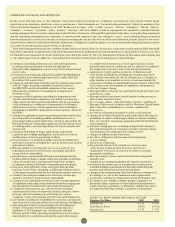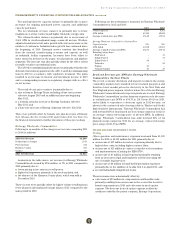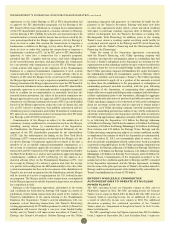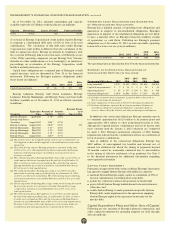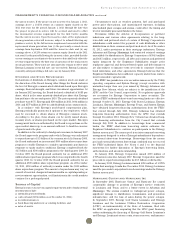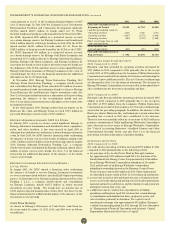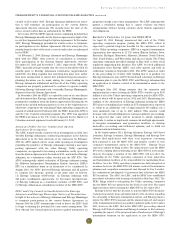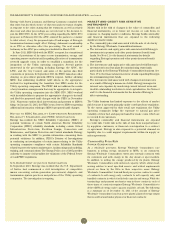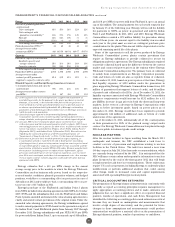Entergy 2011 Annual Report Download - page 41
Download and view the complete annual report
Please find page 41 of the 2011 Entergy annual report below. You can navigate through the pages in the report by either clicking on the pages listed below, or by using the keyword search tool below to find specific information within the annual report.
Entergy Corporation and Subsidiaries 2011
MANAGEMENT’S FINANCIAL DISCUSSION AND ANALYSIS continued
December 2015, and NRC license renewal applications are in process
for these plants. Under federal law, nuclear power plants may continue
to operate beyond their license expiration dates while their renewal
applications are pending NRC approval. Various parties have expressed
opposition to renewal of the licenses. With respect to the Pilgrim
license renewal, the Atomic Safety and Licensing Board (ASLB) of the
NRC, after issuing an order denying a new hearing request, terminated
its proceeding on Pilgrim’s license renewal application. With the ASLB
process concluded the proceeding, including appeals of certain ASLB
decisions, is now before the NRC.
In April 2007, Entergy submitted an application to the NRC to renew
the operating licenses for Indian Point 2 and 3 for an additional 20 years.
The ASLB has admitted 21 contentions raised by the State of New York
or other parties, which were combined into 16 discrete issues. Two
of the issues have been resolved, leaving 14 issues that are currently
subject to ASLB hearings. In July 2011, the ASLB granted the State of
New York’s motion for summary disposition of an admitted contention
challenging the adequacy of a section of Indian Point’s environmental
analysis as incorporated in the FSEIS (discussed below). That section
provided cost estimates for Severe Accident Mitigation Alternatives
(SAMAs), which are hardware and procedural changes that could be
implemented to mitigate estimated impacts of off-site radiological
releases in case of a hypothesized severe accident. In addition to
finding that the SAMA cost analysis was insufficient, the ASLB directed
the NRC staff to explain why cost-beneficial SAMAs should not be
required to be implemented. Entergy appealed the ASLB’s decision to
the NRC and the NRC staff supported Entergy’s appeal, while the State
of New York opposed it. In December 2011 the NRC denied Entergy’s
appeal as premature, stating that the appeal could be renewed at the
conclusion of the ASLB proceedings.
In November 2011 the ASLB issued an order establishing deadlines
for the submission of several rounds of testimony on most of the
contentions pending before the ASLB and for the filing of motions to
limit or exclude testimony. Initial hearings before the ASLB on the
contentions for which testimony is submitted are expected to begin
by the end of 2012. Filing deadlines for testimony on certain admitted
contentions remain to be set by the ASLB.
The NRC staff currently is also performing its technical and
environmental reviews of the application. The NRC staff issued a Final
Safety Evaluation Report (FSER) in August 2009, a supplement to the
FSER in August 2011, and a Final Supplemental Environmental Impact
Statement (FSEIS) in December 2010. The NRC staff has stated its
intent to file a supplemental FSEIS in May 2012. The New York State
Department of Environmental Conservation has taken the position that
Indian Point must obtain a new state-issued Clean Water Act Section
401 water quality certification as part of the license renewal process. In
addition, the consistency of Indian Point’s operations with New York
State’s coastal management policies must be resolved as required by
the Coastal Zone Management Act. Entergy Wholesale Commodities’
efforts to obtain these certifications and determinations continue
in 2012.
The hearing process is an integral component of the NRC’s
regulatory framework, and evidentiary hearings on license renewal
applications are not uncommon. Entergy intends to participate fully
in the hearing process as permitted by the NRC’s hearing rules. As
noted in Entergy’s responses to the various intervenor filings, Entergy
believes the contentions proposed by the intervenors are unsupported
and without merit. Entergy will continue to work with the NRC staff
as it completes its technical and environmental reviews of the license
renewal application.
LIQUIDITY AND CAPITAL RESOURCES
This section discusses Entergy’s capital structure, capital spending
plans and other uses of capital, sources of capital, and the cash flow
activity presented in the cash flow statement.
Capital Structure
Entergy’s capitalization is balanced between equity and debt, as
shown in the following table:
2011 2010
Debt to capital 57.3% 57.3%
Effect of excluding securitization bonds (2.3%) (2.0%)
Debt to capital, excluding securitization bonds(1) 55.0% 55.3%
Effect of subtracting cash (1.5%) (3.2%)
Net debt to net capital,
excluding securitization bonds(1) 53.5% 52.1%
(1) Calculation excludes the Arkansas, Louisiana and Texas securitization
bonds, which are non-recourse to Entergy Arkansas, Entergy Louisiana,
and Entergy Texas, respectively.
Net debt consists of debt less cash and cash equivalents. Debt
consists of notes payable, capital lease obligations, and long-term
debt, including the currently maturing portion. Capital consists of
debt, common shareholders’ equity, and subsidiaries’ preferred stock
without sinking fund. Net capital consists of capital less cash and cash
equivalents. Entergy uses the net debt to net capital ratio and the ratios
excluding securitization bonds in analyzing its financial condition and
believes they provide useful information to its investors and creditors
in evaluating Entergy’s financial condition.
Long-term debt, including the currently maturing portion, makes
up substantially all of Entergy’s total debt outstanding. Following
are Entergy’s long-term debt principal maturities and estimated
interest payments as of December 31, 2011. To estimate future
interest payments for variable rate debt, Entergy used the rate
as of December 31, 2011. The amounts below include payments
on the Entergy Louisiana and System Energy sale-leaseback
transactions, which are included in long-term debt on the balance
sheet (in millions):
Long-Term Debt Maturities 2015- After
and Estimated Interest Payments 2012 2013 2014 2016 2016
Utility $ 721 $ 1,197 $ 614 $ 1,524 $ 10,872
Entergy Wholesale Commodities 24 15 16 21 59
Parent & Other 1,972 43 43 610 535
Total $2,717 $1,255 $673 $2,155 $11,466
Note 5 to the financial statements provides more detail concerning
long-term debt outstanding.
Entergy Corporation has in place a credit facility that has a
borrowing capacity of approximately $3.5 billion and expires in
August 2012, which Entergy intends to renew before expiration.
Because the facility is now within one year of its expiration date,
borrowings outstanding on the facility are classified as currently
maturing long-term debt on the balance sheet. Entergy Corporation
also has the ability to issue letters of credit against the total
borrowing capacity of the credit facility. The facility fee is currently
0.125% of the commitment amount. Facility fees and interest rates
on loans under the credit facility can fluctuate depending on the
senior unsecured debt ratings of Entergy Corporation. The weighted
average interest rate for the year ended December 31, 2011 was
0.745% on the drawn portion of the facility.
39



